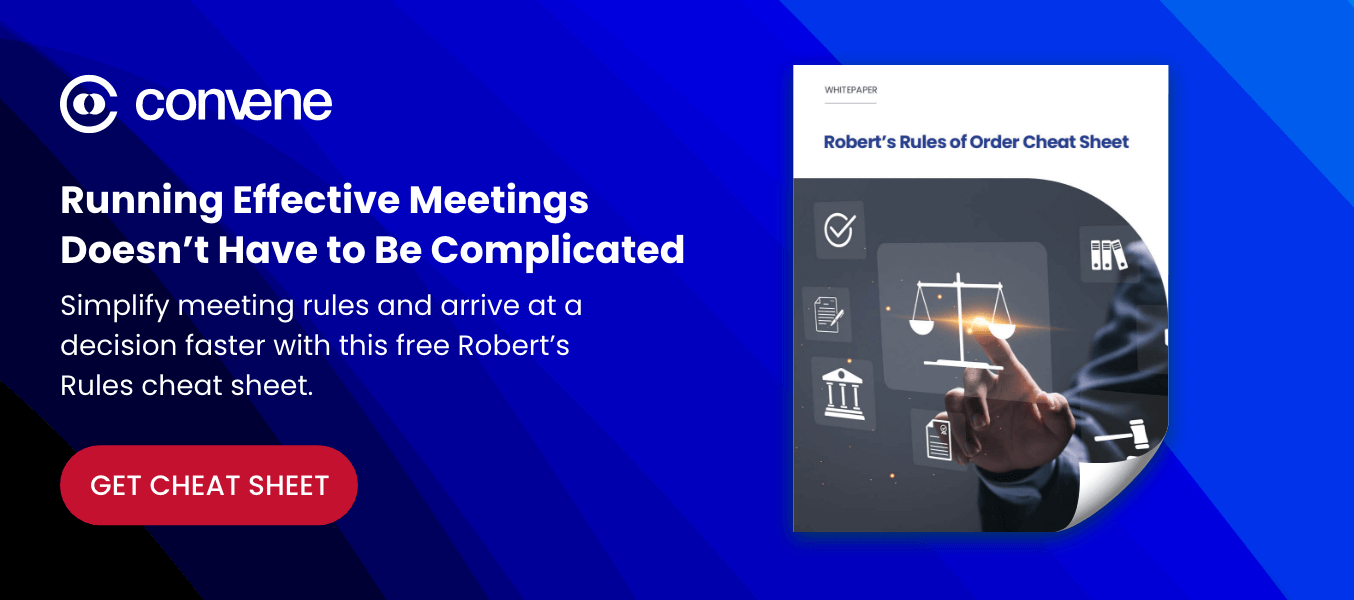Meetings can be powerful tools for productivity, but poorly run ones can dampen energy and damage team morale. Save your team from frustrations by running targeted discussions with well-structured agendas. Define clear objectives, realistic deadlines, and task ownership to enhance engagement and cultivate a more dynamic collaborative environment.
Are you using the right meeting format to achieve your goals? Dive into our comprehensive list of meeting types and see how you can equip yourselves for each with use cases and meeting agenda examples.
What are the types of team meetings and their agendas?

Decision-Making Meetings
Definite decision-making processes are essential if a business wants to become agile and resilient in today’s market landscape. In decision-making meetings, leaders steer the group to make quality decisions and well-planned execution for a specific issue – often documented in writing.
Depending on the preferences of the team, there are several methods for making decisions. This includes voting, delegation, collaboration, consensus, and command. Decision-making meetings are most helpful when choosing new hires, budget approvals, choosing a corporate logo, creating roadmaps, and organizational restructuring. When making decisions, leaders should be able to answer these key questions:
- Which option presents the clearest path forward for the company?
- Which option addresses our current challenges and future aspirations?
- Who is in charge of executing the decision?
Who attends decision-making meetings?
Decision-making should involve key stakeholders with decision-making authority and relevant subject matter expertise. Including too many can lead to prolonged and unfruitful discussions. Here is our proposed participants list for decision-making meetings:
- Meeting facilitator: Ensures that discussions follow the approved agenda and the set time. They keep the meeting focused and guide everyone to make clear and quality decisions.
- Decision-maker(s): These are executives with decision-making authority within the company. Their opinions have a major influence on the final decision.
- Subject matter expert(s): In-house professionals responsible for sharing research and outlining realistic alternatives to help decision-makers in choosing the best option.
- Notetaker: The meeting requires a designated notetaker for thorough documentation of the proceedings. Their role is not to only capture the final decisions, but also the accompanying action plans.
Meeting Agenda Template for Decision-Making
- Opening and Goal Setting: Confirm and clarify the purpose of the meeting and the process by which decisions will be made.
- Present Decision Items: Ensure that everyone agrees on the options and decision items.
- Discussion and Evaluation of Options: Discuss and weigh the advantages and disadvantages of each option.
- Final Decision: Document the decision(s) that have been agreed upon and get the commitment of everyone.
- Execution Planning: List the tasks for execution, their owners, and deadlines.
- Closing and Review: Summarize the meeting outcomes and conduct meeting evaluation.
Problem-Solving Meetings
A problem-solving meeting is focused on finding the root cause of a specific problem and forming a feasible workaround. In contrast to the definitive solutions of decision-making meetings, the solutions that arise from these meetings are more exploratory.
This meeting format is used to resolve urgent issues, such as operational challenges, workplace conflicts, incidents, and customer complaints. To help decision-makers evaluate solutions, teams should prepare a completed situation report coming into the session. The report should answer the questions below to give everyone a thorough rundown and accurate information.
- What is the problem and its root causes?
- What is the urgency of the problem?
- What solutions have been explored in dealing with this problem?
- What roadblocks should we prepare for?
Who attends problem-solving meetings?
Holding a group meeting would generally be a waste of time if one person can handle the problem. However, if one person’s decision has the potential to affect the team, a meeting helps get everyone aligned.
- Decision maker(s): A leader guides the team towards the most feasible solution by encouraging everyone to engage in discussions and share insights. Decision-makers get the last word on the matter after hearing all of the perspectives.
- Parties involved: This group provides the team with firsthand information that helps in understanding the root cause better. This helps leaders develop informed and situation-specific solutions.
Meeting Agenda Template for Problem-Solving
- Opening and Setting of Expectations: Set the goal of the meeting and come to a consensus on the issue.
- Round Robin: List potential solutions and weigh the advantages and disadvantages of each.
- Determine Solution: Decide a course of action.
- Define Action Plan: List the tasks for execution, their owners, and deadlines.
- Closing and Review: Summarize the meeting outcomes and conduct meeting evaluation.
Brainstorming Meetings
Brainstorming meetings are used to generate fresh concepts and solutions for a problem. Unlike the two previous meeting types, this creative technique thrives in informal settings. It helps teams generate ideas for events, develop advertising campaigns, and solve business issues.
Brainstorming methods take several forms including stepladder approach, brainwriting, reverse brainstorming, and rolestorming. After choosing the preferred method, facilitators must be guided by these introductory questions before starting a brainstorming session:
- What are the objectives we want to accomplish today?
- What facts, statistics, or data do we have that will be useful for this session?
- What other information or materials are needed to get around this obstacle?
Who attends brainstorming meetings?
The attendees of brainstorming sessions vary depending on the goal. It can include senior executives and subject matter experts for highly specialized topics.
- Team leads: While leaders do not always need to attend brainstorming sessions, their contribution is valuable in grounding everyone’s ideas.
- Team members: They are useful for generating multiple points of view that enrich the discussion because of their different backgrounds.
- Facilitator: Leaders can sometimes be the facilitators. They are responsible for keeping the conversation on topic and guarantee that everyone participates.
Meeting Agenda Template for Brainstorming
- Set Objectives: Set the goal of the meeting.
- Ground Rules: Discuss the dos and don’ts during the meeting.
- Brainstorming Proper: Ponder, discuss, and build upon each other’s ideas.
- Voting On Ideas: Encourage everyone to take part in an open discussion to delve more into the ideas and have a poll to determine which of the ideas is the best.
- Improve the Ideas: Evaluate the ideas that got the most votes and figure out how to improve or implement them.
- Action Items: List the tasks for execution, their owners, and deadlines.
Onboarding Meetings
The welcoming and integration of a new hire into a company happens during onboarding meetings. It includes a series of introductory meetings to help employees learn about the inner workings of the company, its employees, and its culture. The core agenda of onboarding meetings includes policy briefings, team introductions, onboarding paperwork, and office tours.
Onboarding new hires is primarily led by the human resources department, but other team leads may also attend these meetings to conduct introductions. Here are the guide questions when organizing an onboarding meeting.
- What are the main goals of the onboarding meeting?
- What key knowledge and understanding should new hires have after their onboarding process?
- When and where will the meeting take place?
- Will the meeting be virtual or in-person?
- What format will the onboarding meeting take?
Who attends onboarding meetings?
Onboarding meetings typically include new hires, HR representatives, and relevant team members or leaders. Depending on the company structure and role, additional stakeholders might also be present.
- New hire: As they take center stage in onboarding meetings, they are expected to show enthusiasm as they learn more about their new company.
- Supervisor/Team lead: Their guidance during team inductions ensures new hires feel confident and valued from day one.
- HR specialist: The human resource takes the lead in organizing onboarding meetings. They coordinate with participants, keeping them updated on the schedules and other meeting details.
Meeting Agenda Template for Onboarding
- Welcome Remarks: Introduce new employees and establish clear meeting rules.
- Company Policies: Describe the company’s policies, practices, and history.
- Meeting with the Reporting Manager: Discuss with the manager to establish expectations and define the role’s scope.
- Tour Around Office: Walk through the office and introduce new hire/s to other employees.
- Closing Remarks and Feedback: Check in at the end of the day and evaluate the onboarding program.
Quarterly Planning Meetings
Quarterly meetings break down ambitious yearly goals into smaller and more actionable objectives. This approach makes long-term goals easier to track and achieve. This type is also known as quarterly board meetings, quarterly customer meetings, and quarterly business reviews.
One effective way to run quarterly planning sessions efficiently is to develop a set of guiding questions that organizers can refer to when building the meeting agenda.
- What are our objectives for this meeting, and what were they for the previous quarter?
- What will be the primary focus of this planning meeting (strategic, operational, or tactical)?
- What were we able to accomplish?
- What should we have accomplished?
Who attends quarterly planning meetings?
Quarterly planning can occur at both company-wide and departmental levels. These meetings can be attended by:
- Decision maker(s): Senior executives lead meetings at the company level, concentrating on the larger goals including kick-off meeting agenda, project approvals, and budget allocation.
- Department heads: Team leads form the bridge between high-level plans and execution. They are more on microscopic matters such as team member management and project evaluation.
- Team members: There are instances where individual contributors are invited to quarterly planning meetings. It promotes a sense of ownership and helps them know how their contributions affect the overall goals of the company.
Meeting Agenda Template for Quarterly Planning
- Welcome Remarks and Past Quarter Recap: Welcome the participants and set the goal of the meeting.
- Agenda Approval: Review and confirm the agenda with everyone.
- Review of Strategy: Reconnect with the company’s current strategy to ensure it aligns with the aims of the ongoing meeting.
- Quarter Planning Proper: Outline the targets and priorities for the next quarter.
- Confirmation of Plan: Create the plan for the next quarter and engage all participants.
- Closing: Review the goals and allocate time for final thoughts, meeting evaluation, and appreciation.
Check-in Meetings
Check-in meetings keep teams aligned and on track through quick and recurring huddles. It can happen as group or one-on-one sessions with managers on a weekly, biweekly, or monthly basis. These sessions help build team connections using staff meeting agendas, such as progress updates, coaching, and icebreakers.
Developing an effective agenda for a check-in meeting involves addressing the following guide questions:
- Are there any areas where the team sees an opportunity for improvement?
- What is the top priority between now and the next meeting?
- What roadblocks are the team currently facing? How can it be managed?
- Is there any assignment where the team lacks confidence because of unknowns or challenges?
- How can the team best help each other between now and the next meeting?
Who attends check-in meetings?
Team updates require collaboration among all team members. An ideal check-in meeting allows everyone to talk about their ideas, creating an open discussion, that is free of judgment.
- Team leader: A team lead is responsible for scheduling and facilitating check-in meetings. Being present in meetings helps them identify potential issues early on. This enables the team to make timely course corrections and prevent problems from escalating.
- Team members: Individuals assigned to specific tasks are responsible for keeping managers updated on their progress and any roadblocks encountered.
Meeting Agenda Template for Check-in Meeting
- Personal Check-In: Establish a personal rapport while assessing the general well-being of team members.
- Priorities and Challenges: List the top priorities and challenges of the team.
- Project Updates: Review last week’s priorities and discuss new progress.
- Feedback and Open Discussion: Conduct two-way feedback to strengthen collaboration. Set aside time for team members to ask for recommendations, approval, or help.
- Manager’s List: Review the manager’s priority list and progress tracker to align the agreed-upon tasks.
- Closing and Next Steps: Complete a written documentation of all points discussed and schedule the next meeting.
Best Practices for Creating Meeting Agendas for All Meeting Types

15% of workers’ time in the United States is reportedly spent in meetings, and 71% of those sessions are considered unproductive. These statistics suggest that teams should maximize their meeting experience, which can be initiated by creating an effective agenda.
While crafting an effective agenda and organizing meetings can be challenging, powerful meeting management software can come to the rescue and make the process a breeze. Improve meeting flows by learning these best practices for creating agendas.
1. Automate agenda-building process
Creating an agenda takes two to three hours on average, and longer for complicated meetings. It involves collecting paperwork, appointing facilitators, coordinating time, and compiling notes. Often, these tasks are done on separate platforms, confusing organizers. Automation helps to finish recurring tasks faster, eliminates platform switching, saves time and reduces frustration.
For MS Teams users, Convene in Teams becomes a game-changer for meeting management. With it, users can say goodbye to platform switching! Manage everything seamlessly within Teams; from completing meeting packs to distributing them and managing post-meeting notes.
2. Build and distribute agendas in advance
Prioritize and batch agenda items by categorizing them as informational, discussion topics, or action items. This helps distinguish which themes deserve more time and focus. With the distribution of the agenda, the ideal time for sending them is at least 24 hours before the meeting. This gives ample time for participants to review and prepare their comments.
3. Provide supplementary pre-reading materials
Attaching documents and presentations are supplementary to influencing decisions during meetings. Allowing participants to review them in advance gives them more chances to understand the discussion points and identify possible questions. This makes the discussion more dynamic and productive.
4. Assign facilitators for each agenda item
Meetings often come to a halt during transitions, with awkward pauses breaking the momentum. Pre-appointed facilitators can prevent these dips from happening. Knowing they have been prepped and are ready to guide the discussion, participants feel empowered to join in. This ignites an exchange of ideas that propels the meeting forward.
5. Allocate enough time for each item on your agenda
Meetings are sometimes hampered by overrun topics or rushed discussions. This leaves the participants feeling frustrated, hindering productivity and engagement. Allotting reasonable time slots and adding a buffer ensures all topics get properly addressed, creating a sense of consciousness among participants.
Power Up Agendas and Simplify Meeting Prep with Convene in Teams
Pump up your MS Teams with meeting management software that integrates meeting scheduling, agenda building, and video conferencing on one unified screen. Discover how this technology enhances the effectiveness and productivity of employees in their daily meetings.
Convene in Teams cut 90% of preparation with its powerful meeting organization tools like scheduling assistant and agenda builder. No more hopping between Teams and other MS apps when running meetings! CiT smoothly integrates with MS 365, allowing organizers to conveniently check calendar availability, structure agendas, run meetings, and compile minutes — all inside one platform.
Ready to transform your MS Teams experience? Try Convene in Teams and book a demo today!
Jean is a Content Marketing Specialist at Convene, with over four years of experience driving brand authority and influence growth through effective B2B content strategies. Eager to deliver impactful results, Jean is a data-driven marketer who combines creativity with analytics. In her downtime, Jean relaxes by watching documentaries and mystery thrillers.











